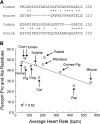Species-specific differences in the Pro-Ala rich region of cardiac myosin binding protein-C
- PMID: 20217194
- PMCID: PMC2839467
- DOI: 10.1007/s10974-010-9207-8
Species-specific differences in the Pro-Ala rich region of cardiac myosin binding protein-C
Abstract
Cardiac myosin binding protein-C (cMyBP-C) is an accessory protein found in the A-bands of vertebrate sarcomeres and mutations in the cMyBP-C gene are a leading cause of familial hypertrophic cardiomyopathy. The regulatory functions of cMyBP-C have been attributed to the N-terminus of the protein, which is composed of tandem immunoglobulin (Ig)-like domains (C0, C1, and C2), a region rich in proline and alanine residues (the Pro-Ala rich region) that links C0 and C1, and a unique sequence referred to as the MyBP-C motif, or M-domain, that links C1 and C2. Recombinant proteins that contain various combinations of the N-terminal domains of cMyBP-C can activate actomyosin interactions in the absence of Ca(2+), but the specific sequences required for these effects differ between species; the Pro-Ala region has been implicated in human cMyBP-C whereas the C1 and M-domains appear important in mouse cMyBP-C. To investigate whether species-specific differences in sequence can account for the observed differences in function, we compared sequences of the Pro-Ala rich region in cMyBP-C isoforms from different species. Here we report that the number of proline and alanine residues in the Pro-Ala rich region varies significantly between different species and that the number correlates directly with mammalian body size and inversely with heart rate. Thus, systematic sequence differences in the Pro-Ala rich region of cMyBP-C may contribute to observed functional differences in human versus mouse cMyBP-C isoforms and suggest that the Pro-Ala region may be important in matching contractile speed to cardiac function across species.
Figures

Similar articles
-
Structure, sarcomeric organization, and thin filament binding of cardiac myosin-binding protein-C.Pflugers Arch. 2014 Mar;466(3):425-31. doi: 10.1007/s00424-013-1426-6. Epub 2014 Jan 11. Pflugers Arch. 2014. PMID: 24413886 Free PMC article. Review.
-
Functional differences between the N-terminal domains of mouse and human myosin binding protein-C.J Biomed Biotechnol. 2010;2010:789798. doi: 10.1155/2010/789798. Epub 2010 Apr 7. J Biomed Biotechnol. 2010. PMID: 20379391 Free PMC article.
-
N-terminal extension in cardiac myosin-binding protein C regulates myofilament binding.J Mol Cell Cardiol. 2018 Dec;125:140-148. doi: 10.1016/j.yjmcc.2018.10.009. Epub 2018 Oct 22. J Mol Cell Cardiol. 2018. PMID: 30359561 Free PMC article.
-
Normal cardiac contraction in mice lacking the proline-alanine rich region and C1 domain of cardiac myosin binding protein C.J Mol Cell Cardiol. 2015 Nov;88:124-32. doi: 10.1016/j.yjmcc.2015.09.006. Epub 2015 Oct 8. J Mol Cell Cardiol. 2015. PMID: 26455481 Free PMC article.
-
Cardiac myosin binding protein C: its role in physiology and disease.Circ Res. 2004 May 28;94(10):1279-89. doi: 10.1161/01.RES.0000127175.21818.C2. Circ Res. 2004. PMID: 15166115 Review.
Cited by
-
N-Terminal Domains of Cardiac Myosin Binding Protein C Cooperatively Activate the Thin Filament.Structure. 2018 Dec 4;26(12):1604-1611.e4. doi: 10.1016/j.str.2018.08.007. Epub 2018 Sep 27. Structure. 2018. PMID: 30270174 Free PMC article.
-
Cardiac myosin binding protein-C as a central target of cardiac sarcomere signaling: a special mini review series.Pflugers Arch. 2014 Feb;466(2):195-200. doi: 10.1007/s00424-013-1396-8. Epub 2013 Nov 7. Pflugers Arch. 2014. PMID: 24196566 Free PMC article. Review.
-
Structure, sarcomeric organization, and thin filament binding of cardiac myosin-binding protein-C.Pflugers Arch. 2014 Mar;466(3):425-31. doi: 10.1007/s00424-013-1426-6. Epub 2014 Jan 11. Pflugers Arch. 2014. PMID: 24413886 Free PMC article. Review.
-
Interaction of the C2 Ig-like Domain of Cardiac Myosin Binding Protein-C with F-actin.J Mol Biol. 2021 Sep 17;433(19):167178. doi: 10.1016/j.jmb.2021.167178. Epub 2021 Jul 27. J Mol Biol. 2021. PMID: 34329643 Free PMC article.
-
Myosin binding protein-C activates thin filaments and inhibits thick filaments in heart muscle cells.Proc Natl Acad Sci U S A. 2014 Dec 30;111(52):18763-8. doi: 10.1073/pnas.1413922112. Epub 2014 Dec 15. Proc Natl Acad Sci U S A. 2014. PMID: 25512492 Free PMC article.
References
-
- Bicer S, Reiser PJ. Variations in apparent mass of mammalian fast-type myosin light chains correlate with species body size, from shrew to elephant. Am J Physiol Regul Integr Comp Physiol. 2007;292(1):R527–R534. - PubMed
Publication types
MeSH terms
Substances
Grants and funding
LinkOut - more resources
Full Text Sources
Miscellaneous

